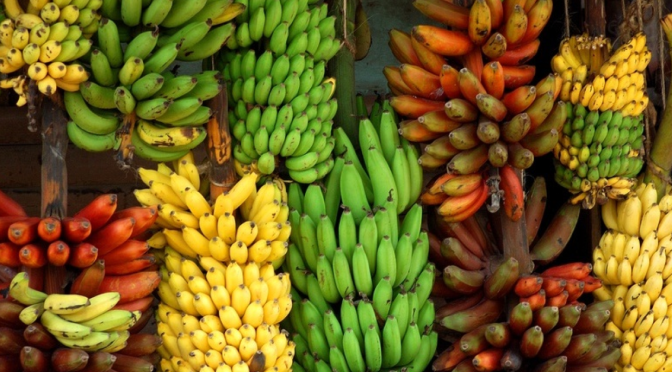
The area under banana crop is gradually increasing in India, particularly as the gestation period of this fruit crop is much short and is not more than 15 months in any of the variety, risk factors are less and profitability is very high.
Nevertheless, many growers are, however, confronted with the question of how the productivity and quality of the fruits could be augmented. Tips on improved methods of banana farming are given below.
It may be noted that only some aspects which have much relevance have, however, been discussed without going into details on improved measures on all aspects of cultivation.
This post gives insights on the varietal selection of bananas:
Banana Varieties
-
There are at least 300 varieties of bananas in India. Among these, which variety (ies) should be selected to grow in a given locality should be judiciously considered, because varietal differences are noticed in respect of their edapho-climatic suitability, susceptibility to disease infection, demand in the market, and on other factors.
-
High wind is another threat in a banana culture that causes the plants to lean or fall or dry. Dwarf varieties like Basrai, Rajapuri, etc. escape high wind as it blows at a higher level. The variety, Poovan (Syn. Lal velchi, Champa, Karpura Chakrakeli, Kadali, Chini Champa ) is though tall but withstand high wind to a considerable extent.
-
Susceptibility or resistance to some particular diseases is found to differ on varieties of bananas. For example, the variety, Basrai is susceptible to the bunchy top and leaf-spot diseases, the famous Gros Michel variety and the variety, Monthan is susceptible to wilt disease, Champa and the famous variety of West Bengal, viz. Giant governors are susceptible to the Sigatoka disease and the like. Again, resistance against Banana wilt disease is observed in some varieties, viz., Poovan, Giant Governor, Martaman, Kanthali, Malbhog, Virupakhsi, Alapan, Rasthali and particularly Basrai. This aspect needs consideration in the selection of varieties.
-
Fruits of which variety (ies) have a greater demand in the market should be given due emphasis in selecting varieties for cropping. In West Bengal, it is found that area under the varieties, Giant Governor, Martaman, Kanthali, etc. is increasing as these varieties have high demand in the markets
Banana Propagation
Choice of propagating materials:
Banana is propagated by suckers. Two types of suckers arise from the rhizome, which are called, ‘water-suckers ’and ‘ sword-suckers ’. Water-suckers have broad, large leaves while the sword-suckers have thin leaves, pseudostems and their tops are pointed.
Although the plants that come out from water-suckers produce fruit at somewhat earlier maturity, the plants that arise from such suckers become diseased. But this is not the case with sword-suckers which produce healthy plants and hence, only sword-suckers should be used. About one meter-long sword-suckers should be taken, their lower ends should be dipped in solutions of 0.2 and 0.5 percent respectively of Bavistin and Monocrotophos, partially dried in shade and then planted.
Click here to know: how to add value to bananas with post-planting care
















